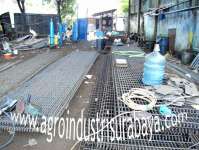PIPA CEMENT LINING , CEMENT LINING PIPE, PIPA CEMENT LINING, CEMENT MORTAR LINING PIPE, DI SURABAYA[Feb. 8, 2012 3:20:46]
Specification
AGRO INDUSTRI SURABAYA
PHONE. 031 60234888, FAX. 031 3980197, EMAIL: INDUSTRI2034@ GMAIL.COM
What are the benefits of pipeline rehabilitation using Cement Lining?
ï ¿ ½ Save 40 ï ¿ ½ 80 % over the cost of replacement
ï ¿ ½ Extend the life of the pipeline for another 50 ï ¿ ½ 100 years
ï ¿ ½ STOP corrosion now!
ï ¿ ½ STOP leaks
ï ¿ ½ Neutralize any adverse effects of the pipeline on the water
ï ¿ ½ Increase flow from 15 ï ¿ ½ 25 %
How long have Cement Lined Pipes been used?
Beginning in the 1800ï ¿ ½ s, cement mortar was found to have excellent anti-corrosive properties for use in water lines. At first, man entry size pipelines were rehabilitated using hand-lining techniques. Eventually, lining machines were developed which allowed for a consistent lining thickness on the pipe wall for both man entry and small diameter pipe. Since then cement mortar lining has been used around the world for new pipe and to rehabilitate old lines.
How does the cement lining protect the pipe?
The internal cement mortar lining provides protection to the pipeline in two ways. First, it is a ï ¿ ½ cement pipe within a steel pipeï ¿ ½ , and second, by creating a ï ¿ ½ Zone of Alkalinityï ¿ ½ . This ï ¿ ½ zoneï ¿ ½ between the cement lining and the pipe wall, neutralizes the corrosive properties of the liquid medium and blocks corrosion of the pipe wall. In effect, the ï ¿ ½ Zone of Alkalinityï ¿ ½ serves as a second layer of defense against internal corrosion. Unlike other types of internal linings, which allow pipe corrosion to spread down the line once they are chipped or damaged in any spot, the cement lining prevents corrosion from spreading along the pipe wall.
What is Autogenous Healing?
Simply stated, autogenous healing is the ability of cement to heal itself. In the presence of moisture, cement extrudes calcium hydroxide which, upon exposure to the atmosphere, is converted to calcium carbonate ( limestone) which seals the crack. This is the same phenomenon that happens when a broken bone is mended. Autogenous healing of cement lined pipe is common when the buried pipe is in the presence of moisture, either on the soil side or inside of the pipe itself. These cracks, when healed autogenously, are stronger than the original cement lining. Evidence of autogenous healing is a whitish substance forming along the crack line.
Conclusion: Even though your pipeline has exfiltration problems, it will stop after it is cement lined!
What is the ï ¿ ½ Arch Effectï ¿ ½ ?
Since there is no chemical bond between steel and cement, the lining process relies on the ï ¿ ½ arch effectï ¿ ½ to hold the cement on the upper portions of the pipe prior to curing.
Once cured, this creates ï ¿ ½ a cement pipe within a steel pipeï ¿ ½ .
What types of finishes are available?
ï ¿ ½ Troweled finish ï ¿ ½ a trowel arm smoothes the lining as the machine exits the line
ï ¿ ½ ï ¿ ½ Orange Peelï ¿ ½ ï ¿ ½ a sprayed on finish, which looks like the surface of an orange.
Does the lining have any strength?
A pressure test was conducted on a length of riveted steel pipe, 48" in diameter and with 1/ 2" pipe wall thickness. The test section was perforated with numerous test holes from 1" to 6-1/ 4" in diameter. The holes were fitted with blanks for application of cement-mortar lining, which was applied in a thickness graduating from 1/ 4" to 1" .
After cutting, the blanks were removed and bulkheads were inserted in the test section for the hydrostatic test. This was to determine at what pressure there might be failure in the cement-mortar lining. The 5/ 8" thick lining of the 6-1/ 4" hole failed at a pressure above 305 psi. No other failures occurred.
This test shows that cement lining can protect pipes even when they have been perforated. Lining new pipe before it goes into service preserves and protects it from internal deterioration.
Can the lining withstand pipe deflection?
A deflection test conducted in the shop on a 72" x 5/ 16" welded steel pipe section demonstrated the amazing deflection properties of cement-mortar lined steel pipe.
A load applied to the top of the section was gradually increased until a total deflection of 13" on the vertical axis was reached and then gradually decreased with no impairment to the lining or any serious cracks.
What types of cement are available for lining?
Generally a type I/ II or type V Portland cement is used, depending upon the salinity of the liquid flowing through the line. However, there is a wide variety of specialty or ï ¿ ½ boutiqueï ¿ ½ cements that can withstand extremely high temperatures, heavy salinity concentrations, and hydrogen sulfide gas and associated corrosives.
Talk to us about your conditions so we can help select the material which best suits your line.
08 / 02 / 12






